Crinum macowanii
| Botanical Name | Crinum macowanii |
|||||||||||
| Family | Amaryllidaceae - The amaryllis family. |
|||||||||||
| Pronunciation | KRYE-num ma-kow-AN-ee-eye |
|||||||||||
| Common Name(s) |
English: Cape Coast lily; Cape Lily; Sabie crinum; Common Vlei Crinum
Afrikaans: Boslelie; Rivierlelie
IsiXhosa: ibhucu; intelezi
IsiZulu: umNduze
|
|||||||||||
| Plant Group |
|
|||||||||||
| Plant Size |
|
|||||||||||
| Position |
|
|||||||||||
| General Information |
|
|||||||||||
| Specific Information | Crinum macowanii has very long, undulating strap leaves growing from an exceptionally large bulb. It is one of the easiest crinums to propagate as it produces many seeds and under prime conditions, may flower within three years. The status of this bulb in the wild is listed as declining, possibly due to harvesting as it is long-lived and in the veld it takes many years to grow to a large size. |
|||||||||||
| Ad Break | ||||||||||||
| Flowers | ||||||||||||
| Description | heavy heads of large white or pinkish trumpet-shaped blooms with rose stripes down center of the petals |
|||||||||||
| Season |
|
|||||||||||
| Colour |
|
|||||||||||
| Growth Rate |
|
|||||||||||
| Plant Uses |
|
|||||||||||
| Distribution and Habitat | from the Eastern Cape to KwaZulu-Natal, Free Stste, Gauteng, Mpumalanga, North West and Limpopo, continuing northwards from Zimbabwe to Eritrea, in mountain grasslands, stony slopes, hard dry shale, gravelly soil and sandy flats |
|||||||||||
| Planting Suggestions | Crinum macowanii will grow well in any soil to which plenty of compost has been added. Plants grow best in full sun but will tolerate light shade. Although drought tolerant, these lilies can not be expected to thrive without plentiful water, especially during the summer months. Crinum Macowanii is a heavy feeder - use 3:1:5 or and organic fertiliser. Spectacular results can then be expected. On the other hand, I have never fed mine and they seldom get water, but have flowered faithfully, although less so during the drought. I also have a couple that grow in the veld with no aid at all, and they too flower annually. Grow in a permanent position as these bulbs resent being disturbed and will take a season or two before they flower. The amaryllis caterpillar is very fond of crinums and a sharp lookout must be kept for these pests as they may even bore right down into the bulb and cause long term damage or even the death of the plant. Unfortunately this caterpillar is poisonous and not eaten by birds, so if you want to avoid the used of pesticides, it will be necessary to physically remove them daily until the season is over. Even if you do use poisons, remember that the young caterpillars will survive your efforts, as the eggs are laid inside the leaf where they are protected. |
|||||||||||
| Medicinal Uses | Crinum species have been used traditionally to cure ailments and diseases. Fibres of the bulb have been used as a dressing on inflamed sores. Crinum species contain highly toxic alkaloids and are not recommended for use by the uninitiated, as a large dose could easily be fatal. |
|||||||||||
| Ad Break | ||||||||||||


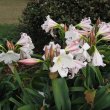
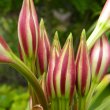
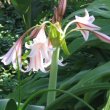
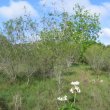

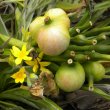


Comments
crinums
I was given some Crinums , they look very tattered and are not in flower, so it is difficult to see which it is, macowanii or moorei. Do you have any suggestions identifying them from quite tattered leaves and the bulbs?
Identifying Crinum bulbs
Hi Yvette
The bulbs themselves are so similar that I can only tell them apart by the manner in which the leaves emerge from the bulb. The leaves of Crinum macowanii emerge directly from the top of the bulb and level with the ground. The leaves of Crinum moorei emerge from a pseudostem of concentric rolled leaf blades that surround the growing point. This pseudostem remains when the leaves die off and becomes thicker and sturdier each year.
I have included a couple of pictures to give you an idea of what to look for. On the left is Crinum macowanii and on the right is Crinum moorei.
I hope this helps. If not, send a picture.
Kind regards
Lorraine
crinums
thank you Lorraine, this is indeed a great help!
Discuss this plant
Share knowledge, ask a question or give an experience.